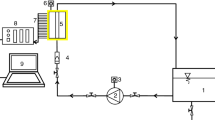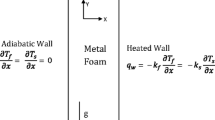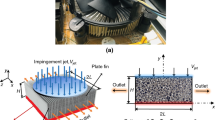Abstract
In addition to the multiple actual or possible applications of metal and ceramic foams in various technological fields, their thermal properties make them a good candidate for utilization as fire barriers. Several studies have shown experimentally their exceptional fire retardance due to their low apparent thermal conductivity. However, while the thermal properties of this porous material have been widely studied at ambient temperature and are, at present, well-known, their thermal behaviour at fire temperatures remains relatively unexplored. Indeed, at such temperatures, the major difficulties are not only due to the fact that thermal measurements are rendered fussy since heavy equipments are required but also stem from the fact that a significant part of the heat transfer occurs by thermal radiation which is much more difficult to evaluate than conductive heat transfer. Therefore, the present chapter is written with a view to report progress on the knowledge of heat transfer in open cell foams and to enlighten the reader on the mechanisms of heat transfer at high temperatures. A first part is devoted to the review of the prior published works on the experimental or theoretical characterisations of radiative and conductive heat transfers from ambient to high temperatures. By taking inspiration from the concepts and models presented in these previous works, we propose, in a second part, a model of prediction of the conductive and radiative contributions to heat transfer at fire temperatures. This analytical model is based on numerical simulations applied to real foams and takes into account the structure of the foam and the optical and thermal properties of the constituents. In a third part, we propose an innovative experimental technique of characterization of heat transfer in foams at high temperatures which permit to evaluate independently the radiative and conductive contributions from a unique and simple measurement. The experimental results obtained on several metal and ceramic foams are compared to the results predicted by our numerical model. The good adequacy between experimental and theoretical results show the consistency of both approaches.












Similar content being viewed by others
Abbreviations
- a :
-
Length of cell struts (m)
- A :
-
Characteristic size of particles interacting with radiation (m)
- d :
-
Thickness of cell struts (m)
- D :
-
Characteristic size of cell lumps (m)
- D cell :
-
Cell diameter (m)
- E c , E h :
-
Emissivities of the hot and cold boundaries
- f s :
-
Fraction of solid phase in struts (-)
- f v = 1 − ε:
-
Solid fraction (-)
- k :
-
Thermal conductivity (W/m/K)
- k c :
-
Effective thermal conductivity (W/m/K)
- k equ :
-
Equivalent thermal conductivity (W/m/K)
- k rad :
-
Radiative conductivity (W/m/K)
- K R :
-
Rosseland extinction coefficient (m−1)
- I λ :
-
Spectral radiative intensity (W/m2/Sr)
- I 0 λ (T):
-
Spectral radiative intensity of the black body at temperature T (W/m2/Sr)
- L :
-
Thickness of the foam slice (m)
- L opt :
-
Optical thickness of the foam slice (-)
- M :
-
Foam density (kg/m3)
- P λ (μ′ → μ):
-
Scattering phase function (-)
- \( \dot{Q} \) :
-
Heat flux density (W/m2)
- q r , q c , q t :
-
Radiative, conductive and total heat flux densities (W/m2)
- \( \vec{r} \) :
-
Position vector
- sp :
-
Specularity parameter (-)
- T :
-
Temperature (K)
- T hot , T cold :
-
Temperatures of the hot and cold boundaries (K)
- V 1, V 2 :
-
Volume of struts and lumps (m3)
- x = πA/λ :
-
Size parameter (-)
- z :
-
1D coordinate (m)
- β, σ, κ :
-
Extinction, scattering and absorption coefficients (m−1)
- β*:
-
Weighted extinction coefficient (m−1)
- \( \vec{\Updelta } \) :
-
Direction vector
- ε:
-
Porosity (-)
- μ:
-
Directing cosine of the radiant intensity (-)
- θ:
-
Scattering angle (rad)
- ρ:
-
Reflectivity (-)
- λ:
-
Wavelength (m)
- σ = 5.67 × 10−8 :
-
Stefan–Boltzmann constant (W/m2/K−4)
- ω:
-
Scattering albedo (-)
- fluid, solid:
-
Relative to the fluid/solid phases
- DOM, ROSS:
-
Calculated by the DOM or the Rosseland Approximation
- ⊥, //:
-
Relative to perpendicular or parallel polarization
- dif, spec:
-
Relative to diffuse or specular reflection
- rad:
-
Radiative
References
Evans, A.G., Hutchinson, J.W. and Ashby, M.F., “Cellular metals”, Current opinion in solid state & materials science 1998, vol. 3, no3, pp. 288-303
Ashby, M.F., Evans, A.G., Hutchinson, J.W. and Fleck, N.A., Metal Foams: A Design Guide. Cambridge University, Engineering Department, Cambridge, 1998
Lu, T.J., Hess, A. and Ashby, M.F., “Sound absorption in metallic foams”, J. appl. Phys. 1999, vol. 85, no11, pp. 7528-7539
Lu, T.J., Stone, H.A. and Ashby, M.F.,”Heat transfer in open-cell foams” Acta mater., 1998, 46, no 10, pp. 3619-3635
S. GAUTHIER, A. NICOLLE, D. BAILLIS, “Investigation of the flame structure and nitrogen oxides formation in lean porous premixed combustion of natural gas/hydrogen blends” International Journal of Hydrogen Energy, 33, 2008, pp. 4893-4905
T.J., Lu and, C., Chen (1999) Thermal Transport and fire retardance properties of cellular aluminum alloys. Acta mater 47(5): 1469-1485
Koch U, Thompson MS, Nardone VC (1994) In: Sanders TH Jr (ed) Proceedings of the 4th international conference on aluminium alloys, Atlanta, Georgia, pp 387–394
Coquard R, Baillis D (2008) Radiative and conductive thermal properties of foams. In: Öchsner A, Murch GE, de Lemos M (eds) Thermal properties of cellular and porous materials, Weinheim, pp 343–384
Solórzano E, Reglero JA, Rodríguez-Pérez MA, Lehmhus D, Wichmann M, de Saja JA (2008) An experimental study on the thermal conductivity of aluminium foams by using the transient plane source method. Int J Heat Mass Transf 51:6259–6267
Russell HW (1935) Principles of heat flow in porous insulators. J Am Ceram Soc 18:1–5
Glicksmann L.R and Schuetz M.A.; In: N.C. Hilyard and A. Cunningham, editors, Low Density Cellular Plastics. Chapman et Hall, London 1994, pp. 104-152
Collishaw P.G.,. Evans J.R.G, An assessment of expressions for the apparent thermal conductivity of cellular materials. J. Mater. Sci. 1994; 29: 486–498
Bauer T.H., A general analytical approach toward the thermal conductivity of porous media. Internat. J. Heat Mass Transfer 1993; 36: 4181–4191
Ahern A., Verbist G., Weaire D., Phelan R., and, Fleurent H., The conductivity of foams: a generalisation of the electrical to the thermal case. Colloids and Surfaces A: Physicochem. Eng. Aspects 2005; 263: 275–279
Boomsma K., Poulikakos D., On the effective thermal conductivity of a three dimensionally structured fluid-saturated metal foam. Int J Heat Mass Transf 2001; 44: pp. 827–836
Bhattacharya A., Calmidi V.V. and Mahajan R.L., Thermophysical properties of high porosity metal foams. Int J Heat Mass Transf 2002; 45: pp. 1017-1031
Fu X., Viskanta R. and Gore J.P., Prediction of effective thermal conductivity of cellular ceramics. Int. Comm. Heat Mass Transfer 1998; 25: pp. 151-160
Singh R. and Kasana H.S., Computational aspects of effective thermal conductivity of highly porous metal foams. Applied Thermal Engineering 2004; 24: pp. 1841–1849
Wang J.F., Carson J.K., J. Willix J., North M.F., Cleland D.J., A symmetric and interconnected skeleton structural (SISS) model for predicting thermal and electrical conductivity and Young’s modulus of porous foams. Acta Materialia 2008; 56: pp. 5138–5146
Druma A.M., Alam M.K. and Druma C., Analysis of thermal conduction in carbon foams. International Journal of Thermal Sciences 2004; 43: pp. 689–695
Saadatfar M., Arns C.H., Knackstedt M.A. and Senden T., Mechanical and transport properties of polymeric foams derived from 3D image. Colloids and Surfaces A: Physicochem. Eng. Aspects 2004; 263: pp. 284–289
Wang M., Pan N., Modeling and prediction of the effective thermal conductivity of random open-cell porous foams. Int J Heat Mass Transf 2008; 51: pp. 1325–1331
Coquard R, Baillis D (2009) Numerical investigation of conductive heat transfer in high-porosity foams. Acta Mater 57(18):5466–5479
Glicksman L, Marge A, Moreno J (1992) Radiation heat-transfer in cellular foam insulation. In: Developments in radiative heat transfer, vol 203. ASME, pp 45–54
Glicksman, L.R., M. Schuetz, and M. Sinofsky, “Radiation Heat Transfer in Foam Insulation,” Int. Jour. Heat Mass Transfer, 30, 1, 187-197, 1987
C.Y. Zhao, T.J. Lu, H.P. Hodson “Thermal radiation in ultralight metal foams with open cells”, Int J Heat Mass Transf 47 (14-16) (2004) 2927–2939
C.Y. Zhao, S.A. Tassou, T.J. Lu, “Analytical considerations of thermal radiation in cellular metal foams with open cells”, Int J Heat Mass Transf 51 (14-16) (2008) pp 929–940
M. Loretz, R. Coquard, D. Baillis and E. Maire, “Metallic foams: Radiative properties/comparison between different models”, Journal of Quantitative Spectroscopy and Radiative Transfer, 109 (1) (2008) 16-27
M. Loretz, E. Maire and D. Baillis, “Analytical Modeling of the Radiative Properties of Metallic Foams: Contribution of X-Ray Tomography”, ADVANCED ENGINEERING MATERIALS vol. 10, 2008, pp.352-360
Zhao CY, Lua TJ, Hodson HP, Jackson JD (2004) The temperature dependence of effective thermal conductivity of open-celled steel alloy foams. Mater Sci Eng A 367(1–2):123–131
R. Coquard, D. Rochais, D. Baillis, “Experimental investigations of the coupled conductive and radiative heat transfer in metallic/ceramic foams”, Int J Heat Mass Transf, Volume 52, Issues 21-22, October 2009, Pages 4907-4918
Takegoshi, E., Y. Hirasawa, J. Matsuo, and K. Okui, “A Study on Effective Thermal Conductivity of Porous Metals,” Trans. of the Japanese Soc. Of Mech. Eng., 58, 879 (1992)
Calmidi, V. V., and R. L. Mahajan, “The Effective Thermal Conductivity of High Porosity Fibrous Metal Foams,” J. of Heat Transf., 121, 466 (1999)
Paek JW, Kang BH, Kim SY, Hyun JM (2000) Effective thermal conductivity and permeability of aluminum foam materials. Int J Thermophys 21(2):453–464
Schmierer E.N., Razani A. “Self-Consistent Open-Celled Metal Foam Model for Thermal Applications”, Journal of Heat Transfer, 2006, Vol. 128, pp. 1194-1203
Mourad Fetoui, Fethi Albouchi, Fabrice Rigollet, and Sassi Ben Nasrallah, “Highly Porous Metal Foams: Effective Thermal Conductivity Measurement Using a Photothermal Technique”, Journal of Porous Media 12(10), 939–954 (2009)
Doermann D. and Sacadura J.F., “Heat transfer in open-cell foams”, Journal of Heat Transfer, 1996, Vol. 118 pp. 88-93
COQUARD R. and Baillis D. “Radiative properties of dense fibrous media in dependent scattering regime”, ASME Journal of Heat Transfer, 2006, vol. 128, n°10, pp. 1022-1030
R. Coquard; D. Baillis, “Radiative Characteristics of Opaque Spherical Particles Beds: A New Method of Prediction”, Journal of Thermophysics and Heat Transfer, 2004, vol.18 n°.2 pp. 178-186
Siegel R. and Howell J.R., “Thermal radiation heat Transfer”, 3rd ed., Hemisphere Publishing Corp., Washington DC, 1992
Brewster, M. Q., Thermal Radiative Transfer and Properties, Wiley, New York, 1992
Barea R, Osendi MI, Ferreira JMF, Miranzo P (2005) Thermal conductivity of highly porous Mullite material. Acta Mater 53(11):3313–3318
David R. Clarke, “Materials selection guidelines for low thermal conductivity thermal barrier coatings”, Surface and Coatings Technology 163–164 (2003) 67–74
Loretz M (2008) Caractérisation des Propriétés Thermiques de Mousses Céramiques et Métalliques à partir d’Analyses Tomographiques aux Rayons X. PhD thesis, Institut National des Sciences Appliquées (INSA) de Lyon, Villeurbanne, France, 2008
Author information
Authors and Affiliations
Corresponding author
Rights and permissions
About this article
Cite this article
Coquard, R., Rochais, D. & Baillis, D. Conductive and Radiative Heat Transfer in Ceramic and Metal Foams at Fire Temperatures. Fire Technol 48, 699–732 (2012). https://doi.org/10.1007/s10694-010-0167-8
Received:
Accepted:
Published:
Issue Date:
DOI: https://doi.org/10.1007/s10694-010-0167-8




